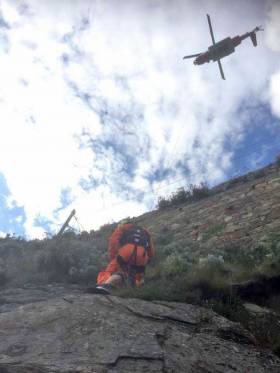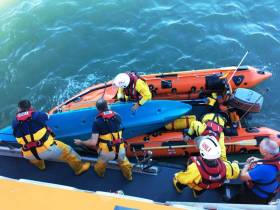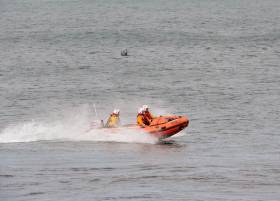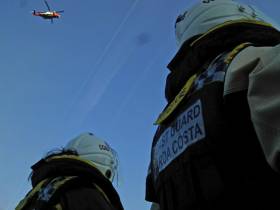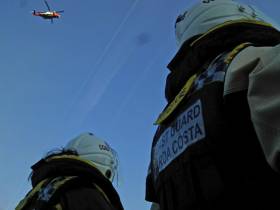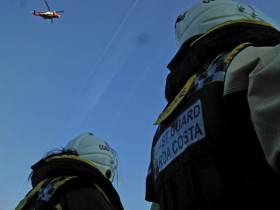Displaying items by tag: Irish Coast Guard
Coastguard Helicopter Air Ambulance Service Is Scaled Back
#Coastguard - Irish Coast Guard helicopter crews will no longer be expected to fly inter-hospital transfers from this week, according to The Irish Times.
It’s understood that the move by the Irish Aviation Authority (IAA) to withdraw coastguard helicopters from night-time air ambulance cover is rooted in its unhappiness with the situation that saw 24-hour SAR pilots doing double duty for patient transfer.
The coastguard’s fleet of Sikorsky S-92 helicopters was first trialled as a Helicopter Emergency Medical Service (HEMS) network almost four years ago.
But HEMS rules which limit missions to pilots on 12-hour shifts with 12-hour breaks between shifts will apply from tomorrow (Tuesday 5 September).
Such overnight missions will now be taken on for the next four weeks by the Air Corps, already the primary provider of air transfers for the National Ambulance Service, using fixed-wing aircraft.
The Irish Times has more on the story HERE.
Divers Rescued In Dalkey Island Drama
#Rescue - Two divers were rescued yesterday afternoon (Sunday 20 August) after they failed to surface during a dive off Dalkey Island.
The dive boat cox alerted the Irish Coast Guard by marine VHF and began a search patter procedure as Dun Laoghaire Coast Guard’s four search units, Dun Laoghaire RNLI’s all-weather lifeboat and the coastguard helicopter Rescue 116 were all tasked to the scene.
The lifeboat and helicopter backed up the dive boat and coastguard search of the coast from Coliemore Harbour to Killiney Beach, a distance of some 15km.
Within minutes, coastguard members searching off Whiterock spotted the divers being pushed towards the coast with the tide and wind as weather conditions worsened.
All vessels were alerted, and the dive boat recovered the two divers, who were said to be in good spirits despite their ordeal.
In a second callout yesterday, Dun Laoghaire Coast Guard volunteers were tasked to assist a 17ft boat with engine failure being towed to Dun Laoghaire Harbour by lifeboat. All aboard were reported in good condition.
Coastguard Rescue For Woman Stranded While Retrieving Drone From Killiney Cliff Face
#Rescue - Drone owners will be mindful of where they fly their devices after a woman was stranded on a cliff face in Killiney while trying to recover one of the mini aircraft.
Dublin MRCC received a 112 call on Tuesday (15 August) from a father whose daughter was stuck on the cliff at Whiterock, after she had attempted to retrieve the drone he had been test flying before it crash landed.
Dun Laoghaire Coast Guard were deployed to the scene along with the Dublin-based Irish Coast Guard helicopter Rescue 116. A request was also extended to the Greystones Coast Guard Cliff Unit to assist.
A Dun Laoghaire coastguard volunteer reached the woman, who had found herself stuck some 30 feet from the cliff base, and made her comfortable until Rescue 116 prepared their winch man to lower her to the beach below. No injuries were reported.
Coastguard In Ongoing Search For Missing Diver Off Donegal
#Coastguard - Sligo’s Irish Coast Guard helicopter Rescue 118 is involved in an ongoing multi-agency search for a diver missing since yesterday afternoon (12 August) off the Donegal coast.
According to TheJournal.ie, the man was part of a group diving wrecks north of Fanad when he disappeared and his colleagues raised the alarm.
Searching resumed this morning (Sunday 13 August) in tandem with Lough Swilly RNLI’s all-weather lifeboat and a number of local vessels.
In other recent coastguard news, Rescue 118 was tasked on Thursday (11 August) to the rescue of a canoeist stranded in the water for four hours in Lough Conn, as The Irish Times reports.
The alarm was raised by two children shortly after they had gone out on the canoe with the man, and managed to swim back to shore after they ended up in the water.
After an exhaustive search of the lough in fading light, the man was found around 10pm and recovered with signs of mild hypothermia – though a coastguard member said his condition could have been worse if the incident occurred in colder conditions.
Thursday (10 August) also saw two callouts for the Irish Coast Guard’s Achill Island unit, the first of which was to a casualty who had fallen from a horse on Keel sandy banks.
Due to the suspected serious nature of the injuries, Rescue 118 was dispatched from its Sligo base to airlift the casualty to hospital.
Meanwhile, the Achill unit assisted paramedics in preparing the casualty for the airlift as well as preparing and securing a landing site for the helicopter.
The second callout was to assist the same National Ambulance Service crew when they were tasked to a suspected stroke.
Again the team assisted packaging the casualty and preparing and securing the GAA pitch in Achill Sound for the Irish Air Corps’ Medevac 112 HEMS helicopter.
Elsewhere, the Shannon-based helicopter Rescue 115 was tasked on Wednesday (9 August) for a medevac from Great Blasket Island.
The patient had to be winched on board the helicopter via a stretcher lift due to the rugged terrain that prevented a landing, before being flown to Tralee University Hospital for treatment.
And previously, Killaloe Coast Guard was tasked last Saturday afternoon (5 August) to assist a jet ski that had broken down on Lough Derg.
A safety vessel from UL Activity Centre which was on exercise in the area had taken the personal water craft in tow until the coastguard crew arrived. The jet ski was then taken back to Ballina slip where it was removed from the water.
#Rescue - The Arklow lifeboat joined Courtown RNLI and the Irish Coast Guard in a multi-agency rescue on Friday evening (11 August) after a teenage girl fell from an inflatable ‘doughnut’ being towed by a jet ski in Courtown Harbour.
Once on scene, around a mile east of Ardamine Beach south of Courtown, the Arklow lifeboat volunteers assisted their Courtown colleagued who were already in the water dealing with the casualty, a 13-year-old girl with suspected spinal injuries.
Arklow RNLI worked to clear the area of other vessels to allow for a safe airlift by the Waterford-based coastguard helicopter Rescue 117.
In the process, they picked up three other casualties — kayakers who had entered the water to assist in the rescue but found themselves adrift.
Independent.ie and The Irish Times have more on the story.
#Rescue - A mother and her two children were rescued from a sea cave at Silver Strand yesterday afternoon (Saturday 29 July) in a joint operation between Wicklow RNLI and the Irish Coast Guard.
The two children had got into difficulty while swimming at the popular beach south of Wicklow Head, and their mother rushed to their aid – only for the three of them to be swept into a nearby cave.
Wicklow RNLI’s inshore lifeboat was launched at 4.40pm and arrived on scene with the Dublin-based coastguard helicopter Rescue 116, which lowered a winchman onto the beach to locate the casualties.
The Wicklow lifeboat followed shortly after, and helm Graham Fitzgerald brought the rescue vessel close to shore where the lifeboat crew spotted three people and the winchman in a cave.
Weather conditions in the area were windy, with a southerly Force 4 and high breaking surf at the mouth of the cave.
After an assessment by the winchman and lifeboat helm, it was decided that the winchman would lead the casualties to the adjoining cave, as rocks at the entrance would impede getting the boat close to shore.
Once the casualties were in the other cave, the lifeboat crew brought the boat onto the beach and all three were transferred to the lifeboat along with the coastguard winchman.
The mother and her two daughters were believed to have been on a day trip to the beach when they decided to go for a swim and one of them got into difficultly. Her sister had tried to help, but also got into trouble.
The mother then entered the water to help her daughters, which resulted in all three of them ending up in the cave.
The winchman, a trained paramedic, assessed the three casualties on the lifeboat and they were brought to Wicklow Harbour, where they were given hot drinks.
Wicklow RNLI were involved in a similar rescue at Silver Stand in 2014 when the lifeboat was called out to rescue a woman who had been swept into a cave after getting into difficulty swimming.
Rescue For Girl Swept Out To Sea In Donegal
#Rescue - Malin Head Coast Guard has issued a warning over changing tides after a series of rescues off the Donegal coast yesterday (Sunday 23 July).
The most serious of these involved a six-year-old girl whose inflatable was swept out to sea at Gweedore, as Independent.ie reports.
The Irish Coast Guard’s Sligo-based helicopter Rescue 118 was quickly dispatched to bring the girl to safety.
Coastguard officials have blamed the changing tide combined with high winds for conditions that also saw three kayakers require assistance in two separate incidents.
Last week Bundoran RNLI gave their own warning over rip currents after a group of GAA players were pulled out to sea.
#Rescue - A cruiser with four on board was aided by the Irish Coast Guard after it suffered engine trouble and snapped its anchor line in poor weather on Lough Derg yesterday (Sunday 2 July).
As BreakingNews.ie reports, the alarm was raised around 1pm yesterday after the 33ft cruiser heading south from Portumna was reported in difficultly near Terryglass.
Killaloe’s coastguard unit, who were training in the area at the time, responded to the distress call and took the cruiser under tow to the safety of Terryglass Harbour before it could run around or become a danger to other vessels.
The incident comes a month after Lough Derg RNLI launched to two yachts that grounded at either end of the lough, as previously reported on Afloat.ie.
#Skibbereen - TheJournal.ie reports that a 14-year-old boy is in critical condition after he was struck in the head by a boom while yachting off Skibbereen yesterday morning (Saturday 24 June).
The teenager was airlifted to Cork University Hospital by the Irish Coast Guard helicopter Rescue 117, and the latest news from Independent.ie is that his condition was improving.
Elsewhere yesterday, Howth Coast Guard attended a 53-year-old man with serious head injuries sustained while kitesurfing off Sutton in North Co Dublin.
And Shannon’s Rescue 115 was called to Inis Mór in the Aran Islands for the medevac of a woman who suffered spinal injuries while taking part in the Red Bull Cliff Diving World Series event.
Heatwave Sees Big Jump In Coastguard Callouts Nationwide
#Coastguard - The Irish Coast Guard has reported a “surge” of calls with a whopping 76 incidents nationwide over the last five days alone, according to The Irish Times.
Average temperatures in the mid 20s have brought more people to the water during the recent heatwave.
That in turn has resulted in increased reports of injuries and missing persons on beaches, and people getting into difficulty while swimming or boating close to shore.
The week’s coastguard calls, which peaked with 18 on Sunday 18 June, include a number of serious incidents.
Paddy McCormick, 62, died in hospital after getting into difficulty with a group while kayaking off Aughris Head in Co Sligo on Monday evening (19 June), as the Irish Mirror reports.
More recently, a teenage swimmer was airlifted to hospital yesterday (Wednesday 21 June) after she was injured jumping off a bridge into the River Slaney in Enniscorthy, Co Wexford.




























